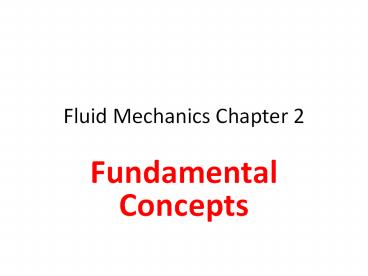Fluid Mechanics Chapter 2 Part II PowerPoint PPT Presentation
Title: Fluid Mechanics Chapter 2 Part II
1
Fluid Mechanics Chapter 2
- Fundamental Concepts
2
Stress field
- Each fluid particle experiences surface forces (
pressure and Friction ) are generated in contact
with other particles or solids - And body forces (gravity and electromegnatic)
- Surface forces lead to stresses
- Stresses in fluid are mostly generated by motion
- The stress at any specified point may be
expressed by nine components - The first subscript indicates surface
perpendicular to a particular axis and second
show direction
3
Concepts of Normal and shear stress
4
Notation for stresses
5
Viscosity
- Where do stresses come from?
- For a solid, stresses develop when the material
is elastically deformed or strained - for a fluid, shear stresses arise due to viscous
flow - Hence we say solids are elastic, and fluids are
viscous - Many biological tissues are viscoelastic, meaning
they combine features of a solid and a fluid)
6
Deformation of Fluids
7
Newtonian Fluids
- Fluids in which shear stress is directly
proportional to rate of deformation are called
Newtonian fluids - Most common fluids such as water, air, and
gasoline are Newtonian under normal conditions - If a fluid is Newtonian then
- The constant of proportionality is called
Absolute or Dynamic viscosity denoted by - The ratio of absolute viscosity to density is
called Kinematic Viscosity and is denoted by
8
Non Newtonian Fluids
- Fluids in which shear stress is not directly
proportional to deformation rate are non-
Newtonian - Examples are toothpaste and Lucite5 paint.
- The paint is very thick when in the can, but
becomes thin when sheared by brushing. - Toothpaste behaves as a fluid when squeezed
from the tube. However, it does not run out by
itself when the cap is removed. - There is a threshold or yield stress below which
toothpaste behaves as a solid
9
(a) Shear stress, t, and (b) apparent viscosity,
?, as a function of deformation rate for
one-dimensional flow of various non-Newtonian
fluids.
10
Apparent Viscosity
- The viscosity is normally constant but apparent
viscosity depends upon shear rate and may be much
higher at certain shear rates for non Newtonian
fluids - Mathematically
11
Types of Non Newtonian fluids
- Fluids in which the apparent viscosity decreases
with increasing deformation rate (nlt1) are called
pseudoplastic (or shear thinning) fluids. - Examples are polymer solutions, colloidal
suspensions, and paper pulp in water - If the apparent viscosity increases with
increasing deformation rate (ngt1) the fluid is
termed dilatant (or shear thickening).
Suspensions of starch and of sand are examples of
dilatant fluids - On the beachif you walk slowly (and hence
generate a low shear rate) on very wet sand, you
sink into it, but if you jog on it (generating a
high shear rate), its very firm.
12
Types of Non Newtonian fluids
- A fluid that behaves as a solid until a minimum
yield stress, ty, is exceeded and subsequently
exhibits a linear relation between stress and
rate of deformation is referred to as an ideal or
Bingham plastic. The corresponding shear stress
model is - Clay suspensions, drilling muds, and toothpaste
are examples of substances exhibiting this
behavior
13
Types of Non Newtonian fluids
- Thixotropic fluids Non-Newtonian fluids in which
apparent viscosity may be time-dependent i.e.
show a decrease in ? with time under a constant
applied shear stress many paints are
thixotropic. - Rheopectic Non Newtonian fluids that show an
increase in ? with time hence called Rheopectic. - Viscoelastic After deformation some fluids
partially return to their original shape when the
applied stress is released such fluids are
called viscoelastic (many biological fluids work
this way).
14
Surface tension
15
Surface tension
16
Surface tension
17
(No Transcript)
18
(No Transcript)
19
Viscous and Invicid flows
20
Reynolds No
- A number given by
- It is used to predict whether viscous forces
acting on a body are negligible as compared to
pressure forces or not - If Re is high, viscous forces are negligible
- If it is low then the viscous forces are not
negligible - If it is neither small nor large, no general
conclusion can be drawn
21
Reynolds No
22
Various concepts
- Inviscid Flow A friction less flow is called
inviscid flow. It has no Viscosity effects - Viscous Flow A flow which involves force of
friction is called viscous flow - Stagnation points where velocity is zero
23
Boundary layer
24
Boundary layer
25
Boundary layer over a streamlined object
26
Laminar and Turbulent Flows
27
Laminar and Turbulent Flows
28
(No Transcript)
29
Compressible and incompressible flows
30
Compressible and incompressible flows
31
Compressible and incompressible flows
32
Internal and External Flows
33
Summary and Useful equations
34
Summary and Useful equations

